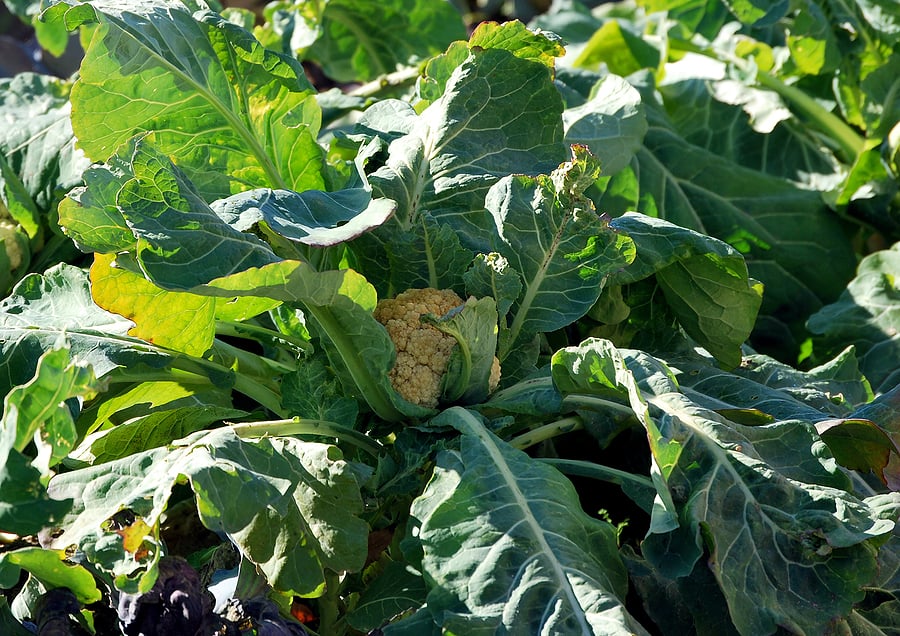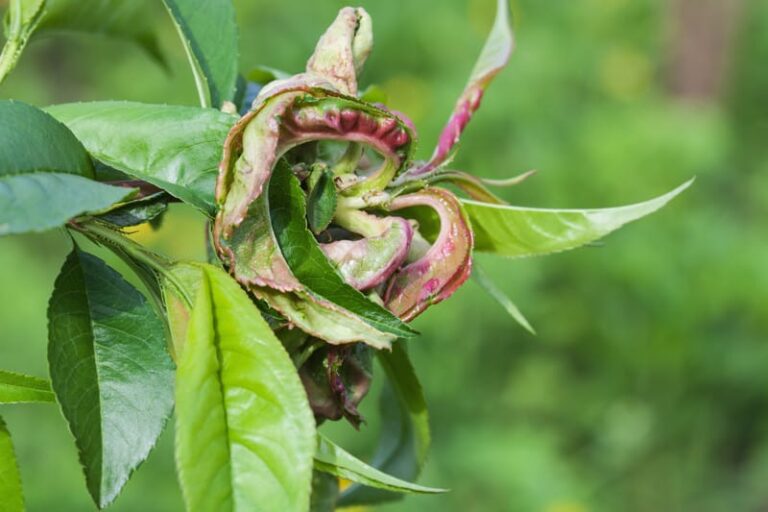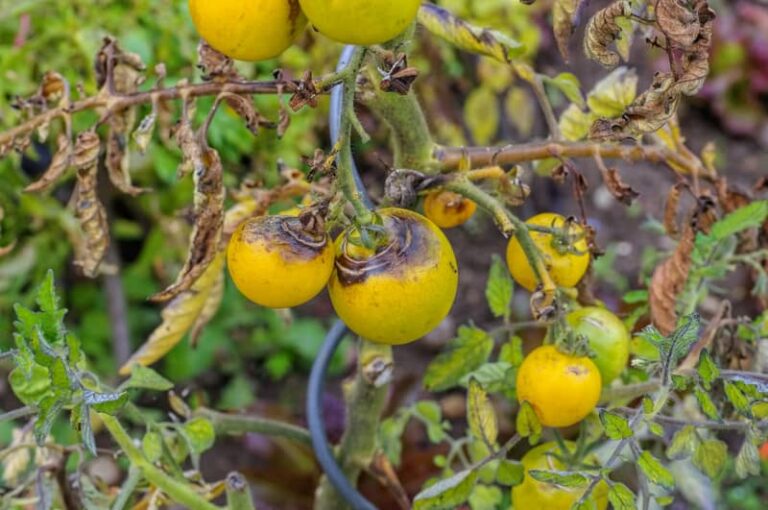Cauliflower Growing Problems: Troubleshooting
Cauliflower is grown much like cabbage but requires more careful treatment. It is best to start cauliflower indoors where it can be protected from both cold and hot temperatures.
Spring-planted cauliflower is likely to face early cold and late heat which will make the effort difficult.
Summer-planted cauliflower for fall harvest will be both easier to grow and more flavorful–cauliflower prefers to leisurely mature in cool weather.
Start the fall cauliflower crop at the same time you plant late cabbage
For cauliflower growing tips see Cauliflower Growing Success Tips at the bottom of this post.
Common cauliflower growing problems with cures and controls:
Seeds and seedling problems
Seedlings fail to emerge from the soil; seedlings are eaten; roots are tunneled.
A cabbage maggot is a small gray-white, legless worm to ⅓-inch long; an adult is the cabbage root fly, which looks like a housefly. Flies lay eggs in the soil near the seedling or plant. Maggots will tunnel into roots leaving brown scars; some plants may be honeycombed with slimy tunnels. Exclude flies with floating row covers. Remove and dispose of damaged plants. Apply lime or wood ashes around the base of plants; time planting to avoid insect growth cycle. Plant a bit later when the weather is drier. Companion plant with mint.
Seeds rot or seedlings collapse with dark water-soaked stems as soon as they appear
Damping off is a fungus that lives in the soil, particularly where humidity is high. Do not plant in cold, moist soil. Make sure the soil is well drained.
Seedlings are eaten or cut off near the soil level
Cutworms are gray grubs ½- to ¾-inch long that can be found curled under the soil. They chew stems, roots, and leaves. Place a 3-inch paper collar around the stem of the plant. Keep the garden free of weeds; sprinkle wood ash around the base of plants
Young sprouts fail to grow or die back; bluish-black spot on leaves and stems
Blackleg is a fungal disease that leaves sprouts girdled and rotting at soil level–“blacklegs.” Blackleg is spread by cutworms and cabbage maggots. Remove and destroy infected plants; keep the garden free of plant debris. Add organic matter to the planting bed; make sure the soil is well-drained. Rotate crops.
Tiny shot holes in the leaves of seedlings
Flea beetles are tiny bronze or black beetles a sixteenth of an inch long. They eat small holes in the leaves of seedlings and small transplants. The larvae feed on the roots of germinating plants. Spread diatomaceous earth around seedlings. Handpick off plants, Cultivate around plants often to disrupt the life cycle. Keep the garden clean. Spade garden soil deeply to destroy larvae in early spring. Treat plants with Sevin, pyrethrum, or rotenone.
Young plants flower
Cold will cause young plants to flower and produce seeds without forming a head. Protect young plants from cold weather with floating row covers; set transplants into the garden no sooner than 1 to 3 weeks before the last average frost date in spring. Don’t plant too early.
Leaf problems
Irregular yellowish to brownish spots on upper leaf surfaces; grayish powder or mold on undersides
Downy mildew is caused by a fungus. Improve air circulation. Plant disease-resistant varieties. Rotate crops. Keep the garden free of plant debris.
Leaves become dull yellow, curl, and the plant may die
Cabbage yellows is caused by the Fusarium soil fungus that infects plants usually where the soil is warm. The disease is spread by leafhoppers. Remove infected plants. Control leafhopper. Keep the garden free of weeds which can harbor disease. Keep soil evenly moist, but not wet. Rotate crops.
Leaves yellow; plant stunted; small glistening white specks on roots
The root cyst nematode is a microscopic worm-like animal that lives in the film of water that coats soil particles. Rotate cabbage family crops. Solarize the soil with clear plastic in mid-summer.
Leaves are yellowish and slightly curled with small shiny specks
Aphids are tiny, oval, whitish-green, pink, or black pear-shaped insects that colonize on leaves. They leave behind sticky excrement called honeydew which can turn into a black sooty mold. Remove with a blast of water. Use insecticidal soap solution. Mulch with aluminum foil to disorient aphids.
Leaves have whitish or yellowish spots; leaves are deformed; plant wilts
Harlequin bugs or stink bugs. Harlequin bugs are black with bright red yellow or orange markings. They suck fluids from plant tissue causing white and yellow blotches. Handpick and destroy bugs and egg masses. Keep the garden free of crop residue and weeds where bugs breed. Spray plants with Sevin, pyrethrum, and rotenone. Stink bugs are gray or green shield-shaped bugs about ¼-inch long; they feed on fruits. Remove garden debris and weeds where bugs can overwinter. Hand-pick egg masses and bugs and destroy them.
Leaves partially eaten; leaves webbed together; eggs in rows on undersides of leaves
Cabbage webworms are green with a light stripe to ¾ inches long; the webworm is the larvae of a brownish-yellow moth with gray markings. Larvae spin light webs. Clip off and destroy webbed leaves. Destroy caterpillars. Keep garden weed free.
Leaves are eaten and plants are partially defoliated.
Blister beetles are slender gray or metallic black beetles to ¾-inch long; they may have striped spots on their wings. Handpick beetles and destroy them. Keep the garden weeds and debris. Cultivate in spring to kill larvae and interrupt the life cycle. Spray or dust with Sevin or use a pyrethrum or rotenone spray.
Large holes in leaves; leaves skeletonized
Cabbage loopers or armyworms. (1) Cabbage looper is a light green caterpillar with yellow stripes running down the back; it loops as it walks. Keep the garden clean of debris where adult brownish night-flying moths can lay eggs. Cover plants with spun polyester to exclude moths. Pick loppers off by hand. Use Bacillus thuringiensis. Dust with Sevin or rotenone. (2) Armyworms are dark green caterpillars the larvae of a mottled gray moth with a wingspan of 1½ inches. Armyworms mass and eat leaves stems, and roots of many crops. Armyworms will live inside webs on leaves. Handpick caterpillars and destroy them. Cultivate after harvest to expose the pupae. Use commercial traps with floral lures.
Leaves are chewed and slimed
Snails and slugs eat leaves. Collect these pests at night. Set beer traps at soil level to attract and drown snails and slugs.
Leaves chewed; tunnels inside cabbage and cauliflower heads
Imported cabbage worm is a pale green caterpillar with yellow stripes to about 1¼ inches long; the adult is a white moth with two or three black spots on the forewing. Use Bacillus thuringiensis. Destroy all remains and weeds after harvest. Companion plant with mint. Encourage the predatory Trichogramma wasp.
Leaves and head become pale green; leaves wilt; slimy rot develops
Bacterial soft rot is caused by Erwinia bacteria. Water-soaked spots appear on leaves and roots; spots enlarge and turn dark and mushy. Black ooze develops in cracks in roots and stems. Rot can not be cured. Collect and burn infected plants Promote good drainage by adding aged compost and organic materials to planting beds. Avoid overhead watering. Rotate crops.
Scorched leaf margins
Molybdenum deficiency in very acid soil. Test soil. Apply lime to produce a neutral soil, pH 6.0 to 7.0. Add about ½ ounce of ammonium molybdate per 500 square feet. Plant disease-resistant varieties: Snowball X, Snowdrift, or Snowball Y.
Head and curd problems
Curds gradually turn brown
Boron deficiency is often found in alkaline soils. Test soil. If deficient, add ½ ounce of borax per 24 square yards.
Heads are loose and yellowish
Too much sun. Lift and tie leaves over the developing heads. Grow plants so that they mature in the cool, moist weather of autumn.
Whole plant problems
Plant wilts; roots are swollen and misshapen, and roots rot
Clubroot is a soilborne fungal disease. Fungus interferes with water and nutrient uptake of roots. Keep the garden clean of plant debris and weeds that can harbor the fungus. Remove and destroy infected plants including soil around roots. Clubroot is found in acid soils; add lime if the soil pH is below 7.2. Rotate crops for at least 2 years. Purchase transplants from disease-free suppliers.
Plant stunted; worms tunnel into roots
Plump grayish grub with a brown head is the larva of the June beetle, a reddish brown or black hard-shelled beetle to 1 inch long. Wireworms are the soil-dwelling larvae of click beetles; they look like wiry-jointed worms. Check the soil before planting; handpick and destroy pests; flood the soil if wireworms are present. Remove infested plants and surrounding soil. Keep the garden free of refuse that could shelter beetle eggs.
Cauliflower growing success tips
Planting
Grow cauliflower in well-drained soil rich in organic matter. Plant cauliflower in full sun in cool regions; where the weather is warm plant cauliflower in afternoon shade. Start cauliflower indoors and transplant it out into the garden about 4 to 5 weeks after seedlings emerge. Seedlings started indoors in early spring should be hardened off before they go into the garden; set seedlings outside for a few hours each day for a week or so before transplanting them out.
Planting time
Cauliflower grows best in cool weather. Transplants can be set in the garden as early as 1 to 2 weeks before the average last frost date in spring; set cauliflower in the garden when the soil temperature has warmed to 55°F and daytime temperatures average in the 50°s and 60°sF. If spring weather warms too quickly, spring-planted cauliflower may bolt and flower prematurely. A summer-planted fall crop is a safer bet: sow cauliflower in the garden about 75 days before the average first frost date in autumn. Mulch summer-planted cauliflower to help keep the soil evenly moist and cool. Where winter temperatures stay mild, cauliflower can be planted in autumn and grown through the winter for spring harvest.
Care
Keep cauliflower evenly moist; do not let the soil dry out. Side dress cauliflower with compost tea every 2 to 3 weeks during the growing season. Mulch cauliflower beds keep the soil cool and conserve soil moisture.
Harvest
Cut cauliflower heads before they get too big when they are about 6 inches across, slightly larger than a softball.
Cauliflower Learning Hub
Start here: The Ultimate Cauliflower Growing Guide: From Seed to Harvest
🌱 Planting & Growing
- When and How to Plant Cauliflower for Best Results
- Cauliflower Seed Starting Tips
- Cauliflower Planting Calendar: Month-by-Month Guide
- How to Transplant Cauliflower Seedlings Successfully
- Proper Cauliflower Spacing for Bigger Heads
- Growing Cauliflower in Containers: Step-by-Step Guide
- Best Companion Plants for Cauliflower (and What to Avoid)
💧 Care & Maintenance
- How to Water Cauliflower the Right Way
- Feeding Cauliflower: Fertilizer Tips for Healthy Growth
- Essential Cauliflower Care: From Seedling to Harvest
- Blanching Cauliflower: Why and How to Do It
🐛 Pests & Problems
🌾 Harvest & Storage
🍴 Kitchen & Use
❓ What to Grow
Cauliflower articles at Harvest to Table:
How to Plant and Grow Cauliflower
Cauliflower Seed Starting Tips
How to Harvest and Store Cauliflower
Cauliflower Growing Problem: Troubleshooting
Seven Easy Ways to Serve Cauliflower
Related articles:
Vegetable Garden Diseases Problem Solver
Vegetable Garden Organic Weed Control
Garden Planning Books at Amazon:






